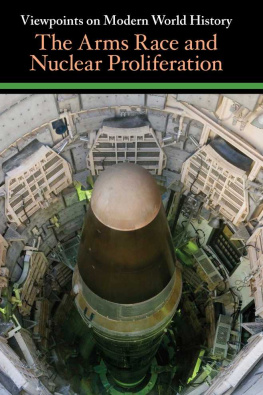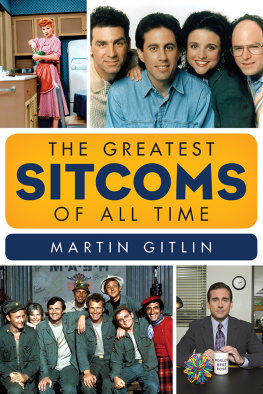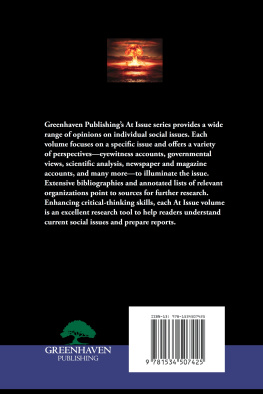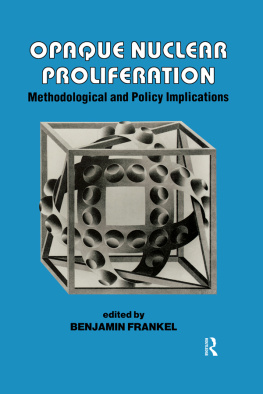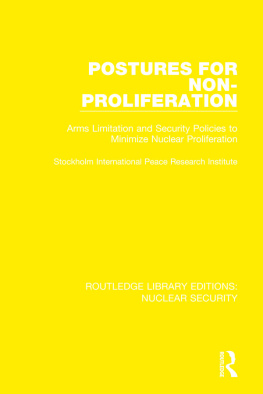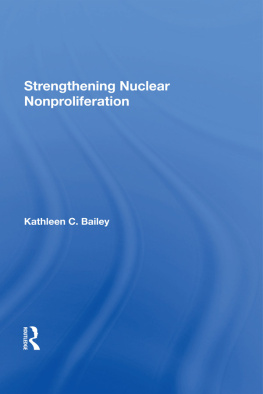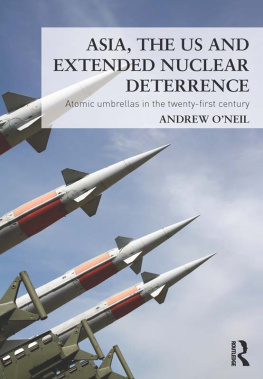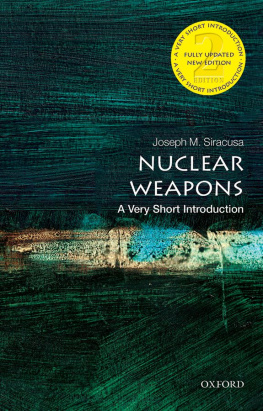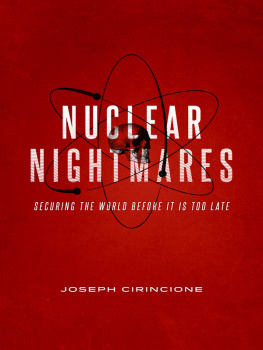Published in 2018 by Greenhaven Publishing, LLC
353 3rd Avenue, Suite 255, New York, NY 10010
Copyright 2018 by Greenhaven Publishing, LLC
First Edition
All rights reserved. No part of this book may be reproduced in any form without permission in writing from the publisher, except by a reviewer.
Articles in Greenhaven Publishing anthologies are often edited for length to meet page requirements. In addition, original titles of these works are changed to clearly present the main thesis and to explicitly indicate the authors opinion. Every effort is made to ensure that Greenhaven Publishing accurately reflects the original intent of the authors. Every effort has been made to trace the owners of the copyrighted material.
Cover image: Michael Dunning/Photographers Choice/Getty Images.
Library of Congress Cataloging-in-Publication Data
Names: Gitlin, Martin, editor.
Title: The arms race and nuclear proliferation / Martin Gitlin, book editor.
Description: New York : Greenhaven Publishing, [2018] | Series: Viewpoints on modern world history | Includes bibliographical references and index. | Audience: Grades 9-12. Identifiers: LCCN 2017028946 | ISBN 9781534501379 (library bound)
Subjects: LCSH: Nuclear weaponsJuvenile literature. | Arms race Juvenile literature. | Nuclear nonproliferationJuvenile literature.
Classification: LCC U264 .A76 2018 | DDC 355.02/17dc23 LC record available at https://lccn.loc.gov/2017028946
Manufactured in the United States of America
Website: greenhavenpublishing.com
Contents
Chapter Preface
Naji Dahi
Various statistical data indicate that fewer lives would have been lost and that World War II would have continued only for two more weeks had the United States not opted to use atomic weapons on Japan in 1945.
George Bunn
The author of this viewpoint stresses that vigilance and goodwill of such countries as the United States and Russia in regard to nuclear nonproliferation is a necessity if the world is to avoid a catastrophe.
Office of the Historian, US Department of State
The US State Department provides a look back at the Cuban Missile Crisis of 1962, an incredibly tense two-week period during which the United States and the Soviet Union brought the world closer to a nuclear war than it had previously ever been.
Nick Blackbourn
The United States and the Soviet Union came very close to nuclear war in 1983 as President Ronald Reagan instituted the Strategic Defense Initiative, which focused on developing a sophisticated anti-ballistic missile shield to prevent attacks from other countries.
Marianne Hanson
Nuclear armament came from superpowers clashing during the Cold War era. Why then, twenty years after the Cold Wars end, are nations still depending on nuclear weapons and the nuclear threat?
Chapter Preface
United Nations
The world has been fortunate to avoid any nuclear exchanges since 1945, but nations must work at getting rid of nukes to ensure that continues. Many factors weigh into that contention.
Experts have long recognized the danger posed by rogue countries with potential nuclear capabilities, such as Iran and North Korea, and the path the rest of the world needs to take to prevent them from using such weapons.
President Obama presented his point of view in 2009 about the future of the world in regard to nuclear securitybut US policy certainly changed after Donald Trump took over the Oval Office.
Zack Beauchamp
There is no clear indication of President Donald Trumps policy on nuclear proliferation, and one must wonder if he knows enough on the subject to have developed one.
James Johnson
Rising tension with North Korea in 2017, escalated by Trumps threats of fire and fury, presents a very real threat of nuclear war in the twenty-first century.
Chapter Preface
The Association for Diplomatic Studies and Training Interviews with experts discuss the Strategic Defensive Initiative, the goal of which was to end the notion that mutually assured destruction (MAD) was the only way to prevent nuclear war.
The scientific community scoffs at the very dangerous notion that there is a foolproof plan to destroy nuclear weapons via any kind of futuristic method.
Gareth Evans
Optimism that disarmament can be achieved through trust, hard work, goodwill, and diplomacy between nations should be encouraged so that hope will remain for a permanent solution.
Black swans are symbols of unseen dangers. Here, the author claims such is the case with nuclear war, which has been an out of sight, out of mind issue for many since 1945.
World government could be a solution to the all-pervasive threat of nuclear war, says one expert, though its an idealistic concept to consider.
Foreword
The more we know about the past enables us to ask richer and more provocative questions about who we are today. We also must tell the next generation one of the great truths of history: that no past event was preordained. Every battle, every election, and revolution could have turned out differently at any point along the way, just as a persons own life can change unpredictably.
David McCullough, American historian
H istory is punctuated by momentous eventsturning points for the nations involved, with impacts felt far beyond their borders. Displaying the full range of human capabilitiesfrom violence, greed, and ignorance to heroism, courage, and strength they are nearly always complicated and multifaceted. Any student of history faces the challenge of grasping both the broader elements and the nuances of world-changing events, such as wars, social movements, and environmental disasters. Textbooks offer only so much help, burdened as they are by constraints of length and singleperspective narratives. True understanding of historys significant events comes from exposure to a variety of perspectives from the people involved intimately, as well as those observing from a distance of miles or years.
Viewpoints on Modern World History examines global events from the twentieth century onward, presenting analysis and observation from numerous vantage points. The series offers high school, early college level, and general interest readers a thematically arranged anthology of previously published materials that address a major historical event or period. Each volume opens with background information on the event, presents the controversies surrounding the event, and concludes with the implications and legacy of the event. By providing a variety of perspectives, this series can be used to inform debate, help develop critical thinking skills, increase global awareness, and enhance an understanding of international viewpoints on history.
Material in each volume is selected from a diverse range of sources. Articles taken from these sources are carefully edited and introduced to provide context and background.
Each volume in the Viewpoints on Modern World History series also includes:

